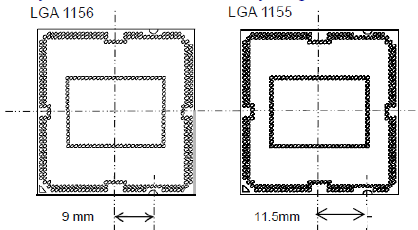
Intel Sandy Bridge: Details of the next gen
We've got details in front of us of Intel's next generation platforms due in 2011, along with its 'Sandy Bridge' CPUs. A third party gave us this information - Intel won't comment on unreleased products.Sandy Bridge CPUs will be based on the current 32nm, second generation High-k metal gate manufacturing process, but will include new architectural features such as AVX - Advanced Vector Extensions - and AES - Advanced Encryption Standard - acceleration and will arrive in Q1 next year, with possibly very limited products popping up late Q4, although depending on who we talk to the story changes.
They will be split into two markets: mainstream and enthusiast. The mainstream models will replace the current LGA1156 'H1' Clarkdale and Lynnfield CPUs (Core i3 and Core i5) and will use LGA1155 'H2' packaging.
Yes, that's right, LGA1155 - one fewer pins than current LGA1156 CPUs. These sockets are NOT compatible, so you cannot use an existing LGA1156 CPU in a new motherboard or visa versa. Not only is the position of pin-1 different, the socket notch has moved from 9mm to 11.5mm from the centre and the entire voltage plane layout has changed.
Mainstream Sandy Bridge CPUs will be both native dual- and quad-core products, currently targeting TDPs of 65W and 95W respectively, both with Hyper-Threading and Turbo Boost technology. At the moment it's not clear what frequency these CPUs will be though (likely because none are available yet from Intel).
All LGA1155 CPUs will have integrated graphics built into the core instead of a separate chip. This is an upgrade from the current IGP, PCI Express controller and memory controller in Clarkdale CPUs that is manufactured on the older 45nm process in a separate die (but still slapped together the same package). This should improve performance, as all the controllers will be in one die, like existing LGA1366 CPUs.

The PCI Express controller available in the CPU will provide 16 lanes, but it will be multi-GPU x8-x8 compatible like current LGA1156 CPUs - however there are currently no specific details about SLI or CrossFire.
The LGA1155 CPUs will have an integrated dual-channel DDR3 memory controller, using the same 1,333MHz memory currently available: no change there then.

Southbridges available for this platform are naturally called P67, H67 and H61 for consumer markets, and Q67 and Q65 for corporate. All of which will support ONFI cache via using Intel's own 34nm and future 25nm NAND, like the H57 chipset currently offers. These Southbridges will not include USB 3 as we've previously reported, but we haven't heard a peep about Intel Lightpeek yet either so expect third party chipsets to still get full use here.
The P67 and H67 chipsets will both feature SATA 6Gbps ports, but unlike AMD's SB850, only a couple will be upgraded and the H61 will not have any. Intel's Matrix RAID Storage driver gets updated to version 10, although we don't think any more varieties of RAID will be available. As usual expect 14 USB 2 ports, again except for H61 that gets 10, and connections to the CPU are via an upgraded 4x PCI-E 2.0 DMI link, with another eight PCI-E 2.0 lanes available for other connections.
All the chipsets include the Protected Audio/Video Path for outputting Blu-ray content, except for the P67. The P67 specifically still has no flexible display interface, and like P55 it eschews the option of using the CPUs internal graphics. In that place there's a 'Performance Tuning' factor, but we have no details of what this is just yet.
Sandy Bridge 'E': Patsburg
Next is Sandy Bridge 'E' (Enthusiast or Extreme, take your pick) 'Patsburg' platform, which features a huge new LGA2011 socket to replace LGA1366 in Q3 next year (although right now that seems dubiously convenient given the year of launch). The larger socket is to accommodate the new four channel DDR3 memory controller this platform will offer, as well as the first outing for PCI Express 3 - of which we'll get 32 lanes bolted into the CPU itself. The lanes can be split between 2x16 and 4x8 for multi-GPU, but again, there's no details about CrossFire or SLI support at this early stage.Like LGA1156/1155 motherboards, LGA2011 motherboards will have only a Southbridge, but whether this Southbridge is called 'X68' (as some Taiwanese manufacturers are saying), we don't yet know. The new Southbridge seems like a complete update with a real focus on the single-socket workstation and server market as it houses two SATA 3Gbps and ten SATA/SAS 6Gbps ports. The interconnect is still a 4x PCI-E 2.0 DMI link between this and the CPU, providing some 2Gbit/s of bandwidth.
That's all for now, we'll keep you updated as we learn more!
Oh, one last thing: one of our sources states LGA2011 will launch with quad-and six-core CPUs (with Hyper-Threading so eight and 12 execution units) although another source has stated eight-core CPUs are also on their way.

MSI MPG Velox 100R Chassis Review
October 14 2021 | 15:04








Want to comment? Please log in.